We tested the Pulsar Helion XP50 thoroughly. This new thermal imaging scope with a revolutionary 640 x 480 pixel sensor, kindly supplied for the test by Adinolfi, Yukon/Pulsar’s Italian distributor based in Monza.
Before moving on to the test itself, let’s take a look at the line this scope comes from.
Presented at the last SHOT Show, the new range of Helion thermal imaging scopes consists of two separate lines of products, and the main difference between the two is the sensor resolution.

The XP line this scope is from has a 640 x 480 pixel sensor, with 17 µm elements, while the XQ line has a 384 x 288 sensor, again with 17 µm elements.
Both the Pulsar XP and the XQ are available with lenses that have a focal length of 50 and 38 mm, with different wide angle lenses fitted to the two models, 28 mm on the XP and 19 mm on the XQ.
The name of the model (Helion XP50 for example) indicates the focal length of the lens.
PULSAR Helion: innovative bayonet mount lens
One really innovative characteristic is the bayonet mount lens, which makes it easily interchangeable, just like the lens of an SLR camera.
This way you can buy lenses with other focal lengths to configure the instrument to meet a variety of observations requirements. The bayonet mount is tropicalized and creates a perfect seal around the instrument when closed. It has to be said though, that the cost of each lens is high.
PULSAR Helion: properties of thermal imaging devices
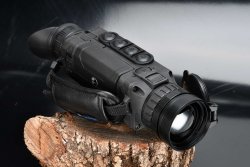
Both have a refresh frequency of 50 Hz; lower frame rates (9hz) are available for non-EU markets and in countries where higher frame rates are illegal. This scope is very compact compared to previous Pulsar generations.
The Helion has a fully sealed glass fibre reinforced Nylon technopolymer casing, and in our opinion it’s more than sturdy enough for professional use. It’s IPX7 certified waterproof (the instrument can be fully immersed in water for short periods of time).
The controls on the top consist of a row of four buttons used to manage all the functions, plus the power ON button. The buttons each have a different feel so the operator can tell which is which even in the dark.
The lens’ bayonet mount release is also on the top, next to the ON button. On the right side there’s a large cutaway where the battery pack is housed, with a USB port beside it to charge the batteries and transfer any videos and photos taken with the instrument.
Furthermore, you can also purchase an optional remote control to control all the scope’s functions from a distance. The remote control has a “wheel” (encoder), which we’ve become used to seeing on all Pulsar scopes, but for a variety of reasons (including the IPX certification) it wasn’t included in the Helion design.
A strap holds the Pulsar Helion firmly on your hand while in use; you can also use a standard neck strap on the instrument and mount it on a normal photographic tripod. The Helion comes with its own lithium ion rechargeable IPS5 battery. It can easy be changed and lasts for eight hours.
There’s also a larger IPS10 battery that increases the autonomy of the instrument to 16 hours, and a case/adapter suitable for normal AA batteries or CR123 lithium batteries.
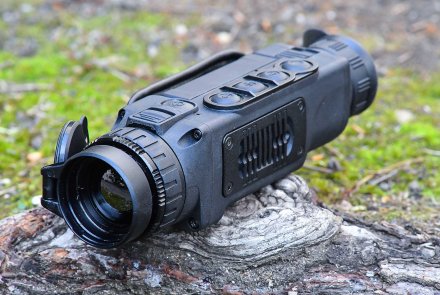
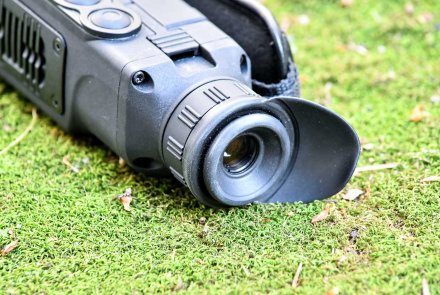
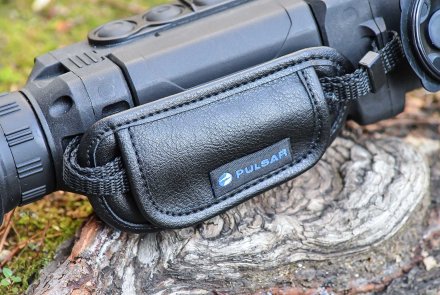
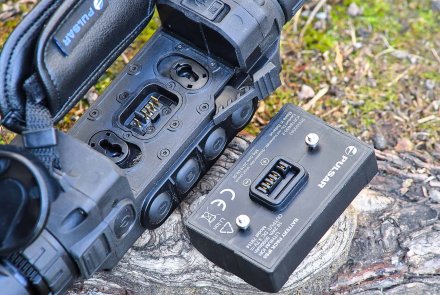
The non-cooled Pico microbolometer sensor is made by ULIS (a company in the French group SOFRADIR) using Resistive Amorphous Silicon technology, and provides an impressive resolution of 640 x 480 pixel; this resolution gives you a much more detailed view than most other thermal imaging systems currently on the market.
Note that the OLED display inside the scope also has a resolution of 640 x 480, so unless the digital zoom is used the video processor doesn’t have to perform any interpolation, as the image has exactly the same number of pixels. The result is a very sharp image on the display. The sensitivity value has also improved thanks to the new sensor, with a NETD value that should be lower than 60 mK.
The instrument powers up in just two seconds. If the ON button is pressed again, it doesn’t turn the whole scope off but just the display; you have to hold the button down for three seconds to turn the instrument off.
PULSAR Helion Thermal Imaging: with integrated video camera
All instruments in the Helion line have a built-in DVR recorder with 8GB of internal memory, so you can film videos and take photos. The 2.4 GHz WiFi connection lets you stream videos of what you’re observing in real time to an Android or IOS smartphone/tablet.
The free Stream Vision app also lets you stream and share videos in real time on YouTube, and control the instrument remotely, or even update the firmware. The remote control function is very interesting as the instrument can also be used as an observation camera. It can even be mounted on a support and used to control the perimeter of high-security installations.
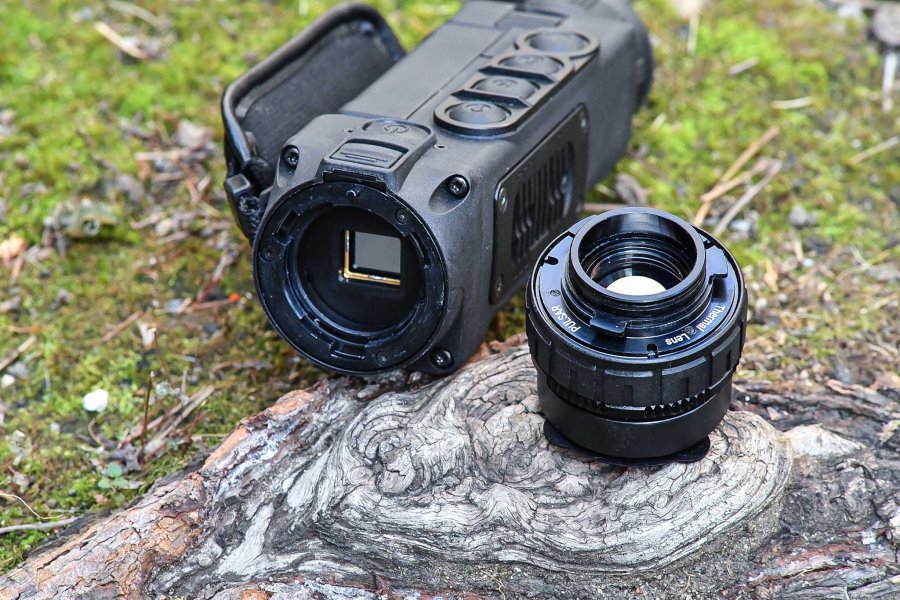
Testing the PULSAR Helion XP50
The Pulsar Helion XP50 thermal imaging scope we tested had a 2.5x optical zoom, plus a 8x digital zoom adding up to 20; the digital zoom can be 3-stage (2, 4 and 8x) or continuous from 1 to 8x.
The scope is very compact. It’s heavy enough in your hand for its size, and feels solid and reliable; with the IPS5 battery supplied it weighs 650 g. The strap lets you hold it like a “camcorder” and your fingers will naturally fall into place over the various buttons to control the instrument’s functions.
The eyepiece is the same as previous versions; in our opinion it’s a little small and not really comfortable to use, although it does give you an excellent view of the color OLED display.
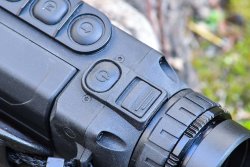
It’s easy to change the lens, and a large O-ring keeps the instrument fully waterproof with the lens mounted; we tried the instrument with a 38 mm lens and it was fully compatible. The instrument is ready-to-use two seconds after start-up.
The image is incredibly sharp and detailed, which is one advantage of the VGA sensor, and even when increasing the magnification using the digital zoom, you’ll only notice a drop in image quality at magnifications of over 2x.
The color palette selection option can be used to highlight the specific temperature variations of the objects or environment observed. The Helion also has the useful interactive stadiametric rangefinder reticle that can measure animals of a known height (hare, 30 cm; boar, 70 cm; deer 1.7 m) and it can also be used to estimate the distance of a man.
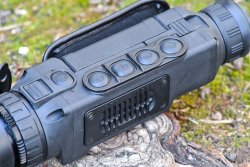
Focusing could be better, the ring is quiet heavily braked; the 38 mm lens was also quite “hard” to focus. The O-ring used to guarantee the IPX7 certification could be the cause.
The travel of the focusing ring is very short and you can adjust the focus from infinity to 3 m (the min. focal distance with a 50 mm lens) in just one quarter of a turn.
To sum up, it’s a very valid high-performance instrument, stronger and more reliable than most and well-suited for professional use. The price hasn’t been published yet, but it won’t be cheap.
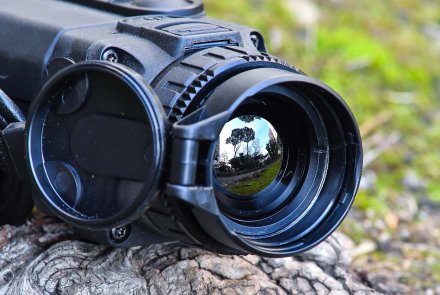
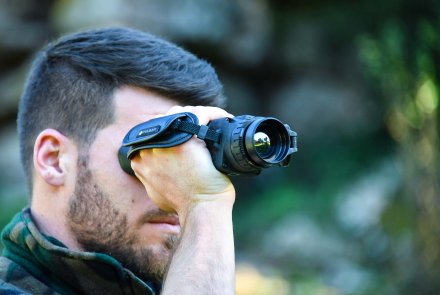
Every Helion thermal imaging scope comes in a nice black Cordura bag with a neck strap, USB cable, manual, an IPS5 battery, and the mains battery charger.
Last but not least, remember than none of the Pulsar “full frame rate” thermal imaging scopes (with a refresh frequency of 50 hz) purchased in Italy, can be exported to any country outside the EEC.

For more informaton, please visit the Pulsar website.











